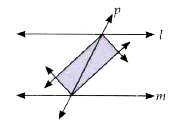If two parallel lines are cut by two distinct transversals, then the quadrilateral formed by the four lines is always a :
square
parallelogram
rhombus
trapezium
To solve the problem, we need to analyze the situation where two parallel lines are intersected by two distinct transversals.
1. Identify the Parallel Lines: Let's denote the two parallel lines as Line 1 and Line 2. For simplicity, we can label them as L1 and L2.
2. Draw the Transversals: Now, we will draw two distinct transversals that intersect both parallel lines. Let's label these transversals as T1 and T2.
3. Mark the Intersection Points: The transversals will intersect the parallel lines at four points. We can label these points as follows:
- A is the intersection of T1 and L1
- B is the intersection of T1 and L2
- C is the intersection of T2 and L1
- D is the intersection of T2 and L2
4. Form the Quadrilateral: The points A,B,C, and D form a quadrilateral. The shape of this quadrilateral is determined by the fact that L1 is parallel to L2.
5. Determine the Type of Quadrilateral: Since L1 and L2 are parallel, the angles formed at points A and B (where T1 intersects) are equal to the angles formed at points C and D (where T2 intersects). This property indicates that the opposite sides of the quadrilateral ABCD are parallel, which defines it as a trapezium.
Conclusion:
Thus, the quadrilateral formed by the two parallel lines and the two distinct transversals is always a trapezium.
- A is the intersection of T1 and L1
- B is the intersection of T1 and L2
- C is the intersection of T2 and L1
- D is the intersection of T2 and L2
Thus, the quadrilateral formed by the two parallel lines and the two distinct transversals is always a trapezium.
Similar Questions
If two parallel lines intersected by a transversal , then name the pair of angles formed that are equal .
View SolutionWhich of the following statements are true (T) and which are false (F)? Give reasons. (i)If two lines are intersected by a transversal, then corresponding angles are equal. (ii)If two parallel lines are intersected by a transversal, then alternate interior angles are equal. (iii)Two lines perpendicular to the same line are perpendicular to each other. (iv)Two lines parallel to the same line are parallel to each other. (v)If two parallel lines are intersected by a transversal, then the interior angle on the same side of the transversal are equal.
View Solution
Knowledge Check
- Question 1 - Select One
If two parallel lines are cut by two distinct transversals, then the quadrilateral formed by these four lines will always be a:
AparallelogramBrhombusCsquareDtrapezium - Question 2 - Select One
If two parallel lines are cut by a transversal, then the alternate interior angles are equal
ATRUEBFALSECCannot be determinedDNone of these - Question 3 - Select One
Two parallel line l and m are intersected by a transversal p. The quadrilateral formed by the bisectors of interior angles is a
 ATrapeziumBKiteCParallelogramDSquare
ATrapeziumBKiteCParallelogramDSquare
Two parallel lines l and m are intersected by a transversal p (see Fig. 8.15). Show that the quadrilateral formed by the bisectors of interior angles is a rectangle.
View SolutionFill in the blanks in each of the following to make the statement true: (i) If two parallel lines are intersected by a transversal, then each pair of corresponding angles are.... (ii) If two parallel lines are intersected by a transversal, then interior angles on the same side of the transversal are... (iii) Two lines perpendicular to the same line are.... to each other. (iv) Two lines parallel to the same line are .......... to each other. (v) If a transversal intersects a pair of lines in such away that a pair of alternate angles are equal, then the line are... (vi) If a transversal intersects a pair of lines in such away that the sum of interior angles on the same side of transversal is 180,then the line are .......
View SolutionIf three or more parallel lines are intersected by two transversal; Prove that the intercepts made by them on tranversal are propotional.
View SolutionIf two parallel lines are intersected by a transversal , then the interior angles on the same side of the transversal are -
View SolutionQuestion Stimulus :-
In the given diagram two parallel lines are cut by a transversal, find the measure of angle 4, if angle 7 = 20∘
 View Solution
View Solution
